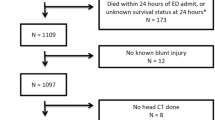Summary
A survey is given of the development and actual state of the prediction of outcome in severe head injury. Thanks to the data collection in some large databanks it has become possible, in a relatively large number of cases, to estimate reliably the chances of survival and the chance of developing an intracranial haematoma base on clinical data and CT obtained during the first 24 hours. Later during the posttraumatic course prediction is possible of the degree of remaining disability in survivors, and the chances of developing epilepsy and neuro-behavioural sequelae. Due to changing management-regimens further datacollection in international databanks is necessary.
Similar content being viewed by others
References
Born JD, Albert A, Hans P, Bonnal J (1985) The relative prognostic value of best motor response and brain stem reflexes in patients with severe head injury. Neurosurgery 16: 595–601
Born JD (1988) The Glasgow-Liège Scale. Prognostic value and evolution of motor response and brains stem reflexes after severe head injury. Acta Neurochir (Wien) 91: 1–11
Braakman R, Gelpke GJ, Habbema JDF, Maas AIR, Minderhoud JM (1980) Systematic selection of prognostic features in patients with severe head injury. Neurosurgery 6: 362–270
Braakman R, Jennett B, Minderhoud JM (1988) Prognosis of the post-traumatic vegetative state. Acta Neurochir (Wien) 95: 49–52
Choi SC, Narayan RK, Anderson RL, Ward JD (1988) Enhanced specificity of prognosis in severe head injury. J Neurosurg 69: 381–385
Gelpke GJ, Braakman R, Habbema JDF, Hilden J (1983) Comparison of outcome in two series of patients with severe head injuries. J Neurosurg 59: 745–750
Jennett B, Teasdale G, Braakman R, Minderhoud J, Heiden J, Kurze T (1979) Prognosis of patients with severe head injury. Neurosurgery 4: 283–289
Levin HS, Hamilton WJ, Grossman RG (1990) Outcome after head injury. In: Vinken, Bruyn (eds) Handbook of clinical neurology, Vol 13 (57). Elsevier, Amsterdam, pp 367–395
Lindsay KW, Carlin J, Kennedy I, Fry J, McInnes A, Teasdale GM (1981) Evoked potentials in severe head injury —analysis and relation to outcome. J Neurol Neurosurg Psychiatry 44: 796–802
Mendelow AD, Teasdale G, Jennett B, Bryden J, Hessett C, Murray G (1983) Risks of intracranial haematoma in head injured adults. BMJ 287: 1173–1176
Teasdale G, Skene A, Parker L, Jennett B (1979) Age and outcome of severe head injury. Acta Neurochir (Wien) 28: 140–143
Teasdale E, Hadley DM (1990) Radiodiagnosis of brain injury. In: Vinken, Bruyn (eds) Handbook of clinical neurolgy, Vol 13 (57) Elsevier, Amsterdam, pp 143–179
Author information
Authors and Affiliations
Rights and permissions
About this article
Cite this article
Braakman, R. Early prediction of outcome in severe head injury. Acta neurochir 116, 161–163 (1992). https://doi.org/10.1007/BF01540870
Issue Date:
DOI: https://doi.org/10.1007/BF01540870




